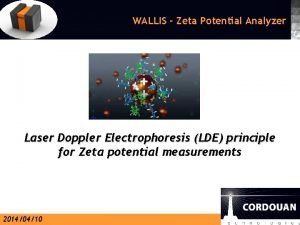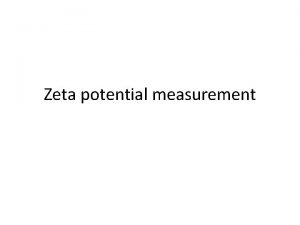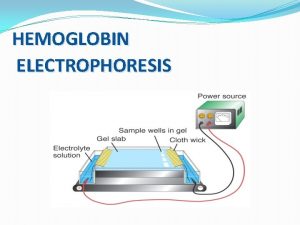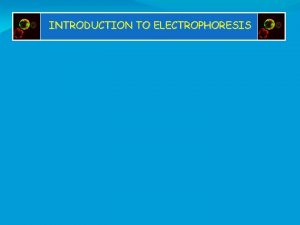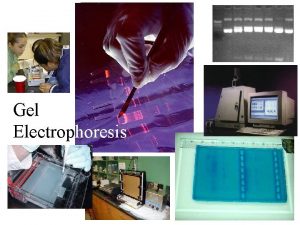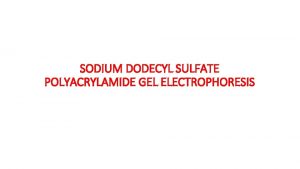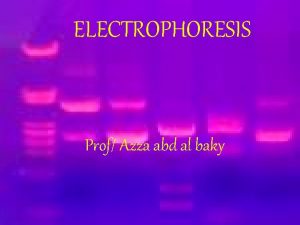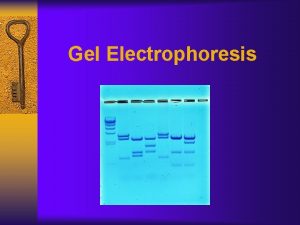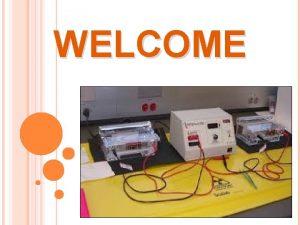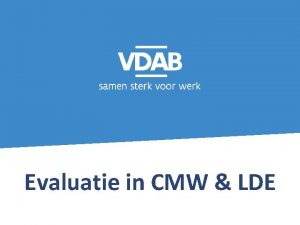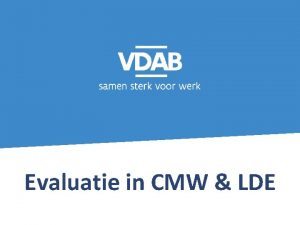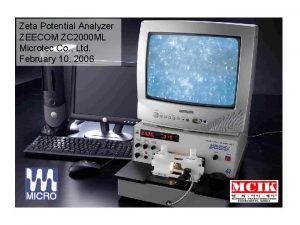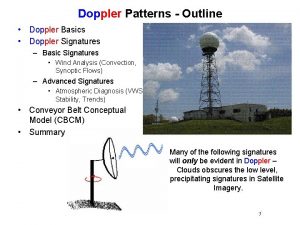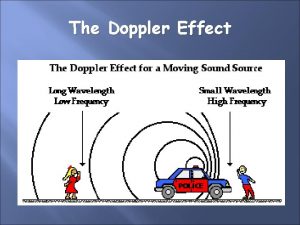WALLIS Zeta Potential Analyzer Laser Doppler Electrophoresis LDE















![Further reading! [1] Hunter R, Zeta potential in colloidal science; Academic press, New York, Further reading! [1] Hunter R, Zeta potential in colloidal science; Academic press, New York,](https://slidetodoc.com/presentation_image_h/0bd1e445eac70a46ecb5759e0bea5074/image-16.jpg)

- Slides: 17

WALLIS - Zeta Potential Analyzer Laser Doppler Electrophoresis (LDE) principle for Zeta potential measurements 2014/04/10

Why measuring Zeta potential? Charged particles repel each other Colloidal solution stability ? Stable systems Flocculations Uncharged particles are free to collide and aggregate Coagulation Sedimentation Ü Electrostatic or charge stabilization : This effect uses more natural interactions between particles through the distribution of charged species (ions) in the solution.

Zeta Potential: a phenomenological approach stable Positive Zeta + 30 m. V unstable 0 m. V IEP : Iso. Electric Point - 30 m. V stable Negative Zeta p. H § If surface has - charge, then Cations are attracted to the NP surface § Anions attracted to Cations, builds electric double layer § Slipping/shear plane: distance from particle surface where ions move with particle § Zeta Potential = potential (m. V) at slipping plane

Zeta Potential determination h z = µe f (k. a) e Calculated Measured z: Zeta Potential (m. V) µe: electrophoretic mobility e: medium permittivity h: medium viscosity a: particle radius k: invert of double layer thickness k-1 : Debye length f (k. a) : Henry’s function Zeta is dependent of the k. a factor value k is dependent of the solvent General cases 1≤ f (k. a) ≤ 1. 5 99% cases !!!

Electrophoresis & Electrophoretic mobility V µe: electrophoresis mobility E: electric field V : voltage applied q : electric charge Fe : electric force Ff : friction force elec • Applying an Electric field: the particles move with its surrounding layers. • Particle velocity directly related to its electrophoretic mobility and E

Laser Doppler Electrophoresis (LDE) Heterodyne optical Interferometer : retrieving doppler low frequency Splitter f laser + f doppler Laser d = 17° flaser + fmod er Combin fmod g Countin Photon Module f doppler tor Path Optical tion Modula Attenua f mod from pectrum S µe = l laser E sin d f. D FFT f mod ± f D µe: electrophoretic mobility (µmcm/Vs) E : applied electric field f. D : Doppler frequency

Wallis Measurement Sequence Heterodyning Signal Measured FFT Doppler shift Electrophoretic Mobility f. D µ Double Layer model Computed Zeta Potential Huckel ? Smoluchowski ? e By LDE (Laser Doppler Electrophoresis) f(k. a) Henry function z

What defines the measurement resolution? 1. 5 Detected signal fmod 1 0. 5 0 0 10 20 30 40 50 60 70 80 90 -0. 5 -1 -1. 5 ØSampling Freq ≥ 2 x fmod (Shannon criteria) ØNber of sampling points limited by : buffer size, acquisition duration, calculation time

WALLIS : High-Resolution Zeta Potential Analysis ØPurely designed and optimized for Charge/zeta potential measurement Ø Complementary tool to VASCO for colloid characterization Ø High resolution analysis down to 0. 5 m. V

Why WALLIS has higher resolution than others? Correlator High-speed digital acquisition: Wallis (2 in 1 concept Zeta+DLS other supplier) 256 to 1024 channels Fmod=256 Hz G 2(t) Intensité 8192 sampling points Fmod=8 k. Hz t t FFT Resolution 3 -5 m. V Resolution < 0. 5 m. V

Sample cell configuration : the dip cell approach Electro-osmosis effect Capillary 3 mm Connector Hellma Cell Quartz, Glass or polystyrene polished No need to focus at any ”stationary plane” Dip cell 10 x 10 mm (WALLIS) Vitreous Carbon Electrodes Laser beam • No electro-osmosis • Field proven concept • Custom made electrodes

Benefits of WALLIS sample cell configuration • • • Easy to handle Easy filling, no risk of bubbles ! (vs capillary cell/viscosity) Stand alone electrode holder-> easy to replace Vitreous carbon electrodes: extreme chemical resistance (No oxidation); low electrical resistance Easy cleaning of electrodes (rinsing and ultra sound bath tub)->No cross contamination Reusable quartz cell-> no consumable Easy to clean Excellent optical quality Compatible with organic solvent Compatible with standard cell (10 x 10 mm 2) … sample volume ≈750µL

Zeta. Q software : the brain of WALLIS § Unique and proprietary software § User friendly and intuitive GUI § SOP and programmable experiments (Time, T°, p. H) § Experiment storage in data base §Many other advanced functionalities

Performances example #1 with correlator (other suppliers) Résolution : 3. 7 m. V !!! with fast acquisition (WALLIS) Résolution < 0, 5 m. V !!!

Performances example #2 IEP characterization of an industrial surfactant WALLIS High resolution allows precise measurement of IEP even with sharp Zeta transition !
![Further reading 1 Hunter R Zeta potential in colloidal science Academic press New York Further reading! [1] Hunter R, Zeta potential in colloidal science; Academic press, New York,](https://slidetodoc.com/presentation_image_h/0bd1e445eac70a46ecb5759e0bea5074/image-16.jpg)
Further reading! [1] Hunter R, Zeta potential in colloidal science; Academic press, New York, 1981 [2] Reliang Xu; Particle Characterization: light scattering methods; Kluwer Academic Publishers [3] ISO 13099 B 1, Colloidal systems—Methods for zeta potential determination Part 1: Electroacoustic and electrokinetic phenomena [4] V. DELGADO et al. ; measurement and interpretation of electrokinetic phenomena; IUPAC Technical Report , Pure Appl. Chem. , Vol. 77, No. 10, pp. 1753– 1805, 2005

Thank you of your attention! Lab support: Customer support: Dr. Benoit MAXIT Eng. Boris PEDRONO Mail: benoit. maxit@cordouan-tech. com Mail: boris. pedrono@cordouan-tech. com CORDOUAN TECHNOLOGIES +33 556 157 545 +33 556 157 541 Cité de la photonique 11, Avenue Canteranne 33600 Pessac FRANCE www. cordouan-tech. com Follow Cordouan Technologies on Twitter!
 Laser doppler electrophoresis
Laser doppler electrophoresis Lde meaning math
Lde meaning math Blue yonder lde
Blue yonder lde Refractory period action potential
Refractory period action potential Electric potential and potential difference
Electric potential and potential difference Source of bioelectric potential is
Source of bioelectric potential is Potential and potential difference
Potential and potential difference Water potential
Water potential Market potential and forecasting
Market potential and forecasting Graded vs action potential
Graded vs action potential Potential due to an electric dipole
Potential due to an electric dipole Transmission across a synapse
Transmission across a synapse Graded potential vs action potential
Graded potential vs action potential Define electric potential and potential difference.
Define electric potential and potential difference. Saltatory conduction
Saltatory conduction Electric potential
Electric potential Osmotic potential vs water potential
Osmotic potential vs water potential Axon hillock
Axon hillock
